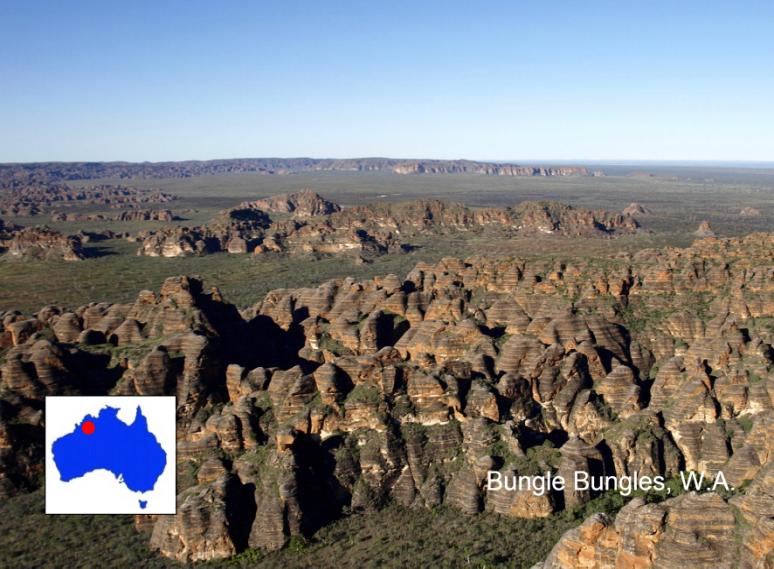
Bungle Bungle Mountains, Purnululu National Park, Western Australia
Extract from National Rock Garden Newsletter No. 5, January 2013
Description from UNESCO, World Heritage List (http://whc.unesco.org/en/list/1094).
The Bungle Bungle Mountain Range is one of the landscapes within the Purnululu National Park located in the East Kimberley Region of Western Australia 300 km by road south of Kununurra in Western Australia’s Ord Region. The listed area of the national park is almost 240,000 ha. The Bungle Bungle Range is one of the most extensive and impressive occurrences of sandstone tower karst in the world.
The Bungle Bungle Mountains are an unusual and very dramatic plateau of Devonian quartz sandstone, created through a complex process of sedimentation, compaction, uplift (caused by the collision of Gondwanaland and Laurasia approximately 300 million years ago and the convergence of the Indo-Australian Plate and the Pacific Plate 20 million years ago), as well as long periods of erosion. The Bungle Bungle landscape comprises a mass of beehive-shaped towers with regularly alternating, dark grey bands of cynobacterial crust (single-cell photosynthetic organisms).
The plateau is dissected by 100-200 m deep, sheer-sided gorges. The cone-towers are steep-sided, with an abrupt break of slope at the base and have domed summits. Their surface is fragile but stabilized by crusts of iron oxide and bacteria. They provide an outstanding example of land formation by dissolution weathering of sandstone, with removal of sand grains by wind, rain and sheet wash on slopes.

The prime scenic attraction within the national park is the extraordinary array of banded, beehive-shaped cone towers comprising the Bungle Bungle Range. These have become emblematic of the park and are internationally renowned among Australia’s natural attractions. The dramatically sculptured structures, unrivalled in their scale, extent, grandeur and diversity of form anywhere in the world, undergo remarkable daily and seasonal variation in appearance, including striking colour transition following rain and with the positioning of the sun. The intricate maze of towers is accentuated by sinuous, narrow, sheer-sided gorges lined with majestic Livistona fan palms. These and the soaring cliffs up to 250 metres high are cut by seasonal waterfalls and pools, creating the major tourist attractions in the park.
Purnululu National Park is currently one of the 12 Australian natural heritage sites listed on the UNESCO World Heritage Register. To date there are 188 UNESCO natural heritage sites listed world-wide.


